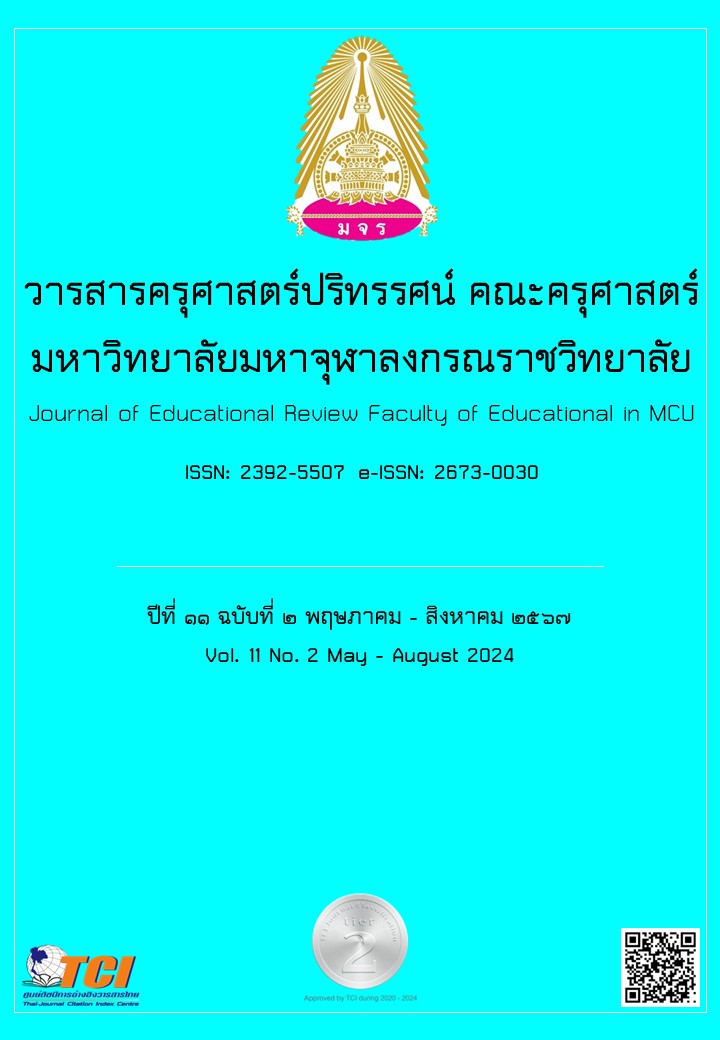CREATING THE KNOWLEDGE SET OF DEVELOPMENT OF LEARNING INDIVIDUAL BEHAVIORS ACCORDING TO THE SIX CARITA IN THE TIPITAKA
Main Article Content
Abstract
This research article aimed to 1) study the development of learning behaviors according to the 6 temperaments, 2) create a knowledge set on the development of learning behaviors of individuals according to the 6 temperaments, and 3) propose the creation of a knowledge set on the development of learning behaviors of individuals according to the 6 temperaments in the Tripitaka. This was a qualitative field research by collecting data from documents and in-depth interviews with 15 key informants. The data were analyzed in terms of content. The research results found that 1) the development of learning behaviors of individuals according to the 6 temperaments in the Tripitaka consisted of people with Rga-carita: one of lustful temperament, people with Dosa-carita: one of hating temperament, people with Moha-carita: one of deluded temperament, people with Saddh-carita: one of faithful temperament, people with Buddhi-carita: one of intelligent temperament, people with Vitakka-carita: one of speculative temperament. 2) The creation of a knowledge set on the development of learning behaviors of individuals according to the 6 temperaments consisted of people with Rga-carita: one of lustful temperament, such as the cases of Phra Nanda and Phra Khema Theri. Dosa-carita was a person whose behavior tended to be hot-tempered and easily angered, such as the case of the glass carpenter. Moha-carita was a person whose behavior tended to be foolish, think less and lazy, such as the case of the Thandaki Forest. Saddh-carita was a person with gullible, such as the case of the Venerable Vakkali. Buddhi-carita was a person who liked to use wisdom, intelligent, having quick wit, such as the cases of a graduated novice. Vitakka-carita was a person with anxious and fearful, such as a case study of Nakkhatta Jataka. 3) A set of knowledge on the development of learning behavior of individuals according to the 6 temperaments in the Tripitaka, consisting of the development of learning behavior of individuals, people with Rga-carita should develop Asubha and Kyagatsati. People with Dosa-carita should develop Kasiṇa and Brahmavihra. People with Moha-carita should develop nāpānasati. People with Saddh-carita should develop the 6 Anussati. People with Buddhi-carita should develop Maraṇasati, Upasamanusati, hārepaṭikūlsaññā. People with Vitakka-carita should develop nāpānasati.
Article Details

This work is licensed under a Creative Commons Attribution-NonCommercial-NoDerivatives 4.0 International License.
ทัศนะและความคิดเห็นที่ปรากฏในบทความในวารสารฉบับนี้ถือเป็นความรับผิดชอบของผู้เขียนบทความนั้นเพียงผู้เดียว และไม่ถือเป็นทัศนะและความรับผิดชอบของกองบรรณาธิการ
กองบรรณาธิการขอสงวนสิทธิ์ในการคัดเลือกบทความลงตีพิมพ์และจะแจ้งให้เจ้าของบทความทราบหลังจากผู้ประเมินบทความตรวจอ่านบทความแล้ว
ต้นฉบับที่ได้รับการตีพิมพ์ในวารสารครุศาสตร์ปริทรรศน์ คณะครุศาสตร์ มหาวิทยาลัยมหาจุฬาลงกรณราชวิทยาลัย ถือเป็นกรรมสิทธิ์ของคณะครุศาสตร์ มหาวิทยาลัยมหาจุฬาลงกรณราชวิทยาลัย ห้ามนำข้อความทั้งหมดหรือบางส่วนไปพิมพ์ซ้ำ เว้นเสียแต่ว่าจะได้รับอนุญาตจากมหาวิทยาลัยฯ เป็นลายลักษณ์อักษร
References
พระธรรมปิฎก (ป. อ. ปยุตฺโต). (2543). พจนานุกรพุทธศาสตร์ ฉบับประมวลธรรม. กรุงเทพมหานคร: มหาวิทยาลัยมหาจุฬาลงกรณราชวิทยาลัย.
พระพุทธิพงศ์ ปภากโร (แร่ทอง). (2551). สภาพและปัญหาการจัดการเรียนรู้ตามแนวไตรสิกขาในโรงเรียนมัธยมศึกษา: กรณีศึกษา เฉพาะเขตตลิ่งชัน กรุงเทพมหานคร. วิทยานิพนธ์พุทธศาสตรมหาบัณฑิต. มหาวิทยาลัยมหาจุฬาลงกรณราชวิทยาลัย.
พระอุปติสสเถระ. (2541). วิมุตติมรรค. แปลโดย พระราชวรมุนี (ประยูร ธมฺมจิตฺโต) และคณะ, พิมพ์ครั้งที่ 5. กรุงเทพมหานคร: สำนักพิมพ์ศยาม.
มหาจุฬาลงกรณราชวิทยาลัย. (2539). พระไตรปิฎกภาษาไทย ฉบับมหาจุฬาลงกรณราชวิทยาลัย, กรุงเทพมหานคร: โรงพิมพ์มหาจุฬาลงกรณราชวิทยาลัย.
ยุกตนันท์ หวานฉ่ำ. (2555). การบริหารสถานศึกษากับประสิทธิผลของโรงเรียนในอำเภอคลองหลวง สังกัดสำนักงานเขตพื้นที่การศึกษาประถมศึกษาปทุมธานี เขต 1. วิทยานิพนธ์ศึกษาศาสตรมหาบัณฑิต. มหาวิทยาลัยเทคโนโลยีราชมงคลธัญบุรี.
วิภาพรรณ พินลา. (2556). แนวทางการจัดการเรียนรู้วิชาสังคมศึกษา เพื่อพัฒนาทักษะการคิดอย่างมีวิจารณญาณสำหรับผู้เรียนในศตวรรษที่ 21. วิทยานิพนธ์ศึกษาศาสตรมหาบัณฑิต. มหาวิทยาลัยทักษิณ.
สำนักงานคณะกรรมการการประถมศึกษาแห่งชาติ. (2540). ประสิทธิภาพการบริหารโรงเรียนประถมศึกษา. กรุงเทพมหานคร: สามเจริญพานิช.
อารีย์ พรมมา. (2556). การส่งเสริมการเรียนรู้ด้วยตนเองของนักเรียนในโรงเรียนเคียวนำ สังกัดสำนักงานเขตพื้นที่การศึกษาการประถมศึกษาศรีสะเกษ เขต 2. วิทยานิพนธ์ศึกษาศาสตรมหาบัณฑิต. มหาวิทยาลัยนอร์ทกรุงเทพ.


